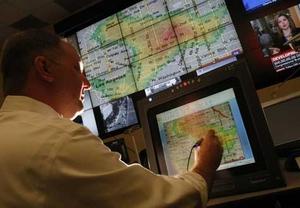Law enforcement technologyLAPD to rely solely on computers to fight crime
In an unprecedented move, for the next three months the Los Angeles Police Department (LAPD) will rely entirely on computer software to decide where to deploy patrol officers; the predictive analytics software examines data from past crimes to determine when and where certain crimes are likely to occur next so police can be on hand to stop them before they are committed

LAPD launches pilot program relying on software for deployment // Source: computerworld.hu
In an unprecedented move, for the next three months the Los Angeles Police Department (LAPD) will rely entirely on computer software to decide where to deploy patrol officers.
Captain Sean Malinowski of the LAPD is a staunch advocate of using predictive analytics to examine data from past crimes to determine when and where certain crimes are likely to occur next so police can be on hand to stop them before they are committed.
To test his theories on predictive policing, on 6 November, Malinowski launched a three month trial program in his area of command.
“We’re doing a rigorous examination, an experiment, for the next three months of predictive analytics and for the first time we’re going to rely 100 percent on the computer to forecast property crimes, which are the lion’s share of our crime,” he said.
Malinowski hesitates to relinquish control in his jurisdiction but is more than willing to make some sacrifices if it results in a drop in the crime rate.
“That’s unusual for me to do because, as a [commanding officer], I like to be in control of things, especially the mission,” he said. “But I’m going to give that up and I’m going to let the computer generate the geographic assignment of the missions.”
As police departments across the country struggle with budget cuts, more and more have turned to technology and new policing tactics like predictive analytics to help make existing resources more effective.
The LAPD and Santa Cruz Police Department in particular have taken to deploying predictive software developed by social scientists and mathematicians at the University of California Los Angeles (UCLA).
The software is modeled after a mathematical algorithm used to predict earthquakes and their aftershocks. Researchers discovered that like aftershocks, which occur in close proximity to an earthquake’s epicenter, criminals commit crimes in close proximity to past crimes.
The software works best at predicting property crimes like home burglaries and vehicle thefts as these targets are stationary and do not change that much over time in comparison to homicides or assault victims who are mobile and can change their behavior.
Criminologists say property crimes are easier to predict because there are patterns governing when and where they will occur. For instance, burglaries often occur around the same time and general location.
Earlier this year, the Santa Cruz Police Department acted as an early test case for the predictive system and found that it immediately helped reduce crime.
“In the first month, July 2011, the only variable we introduced was the application of this model and there was a 27 percent reduction year-over- year of the targeted crime types, because there was a police presence in the area where maybe there wouldn’t have been a police presence at all,” said Zach Friend, a crime analyst with the Santa Cruz police.
Friend explained that each day the software is recalibrated to produce ten Google hotspot maps that indicate a 500 square foot area where a burglary or vehicle theft is likely to occur that day. At roll call, the maps are distributed and patrol officers will check those areas when they are not responding to other calls.
“Law enforcement in the past has taken a reactive approach to enforcement - if crime occurs in one place you need to go to that place,” Friend said. “This is breaking that mold. You don’t necessarily have to go there. Maybe it will send you to a separate location to prevent the next crime from occurring.”
Santa Cruz does not have enough crime so the test was not able to conclusively find a correlation between a decrease in crime to the use of the predictive software, which is where the pilot program in Los Angeles comes in.
Malinowski said he is currently the only station in the LAPD that is participating in the experiment and he hopes that it will result in clear proof that using computer forecasts can quantifiably minimize crime.
“We’re experimenting and we’ll see how it goes and if it will answer the questions: ‘Does the forecast add value to the process of assigning missions for patrol?’ and ‘Will it give us some information on how many officers we need in a certain part of our jurisdiction and for how long?’ and ‘Will it make an impact on property crime in a certain very small geographic space like a block?’ We’re going to be collecting data as well so we’ll be able to track that,” he said.
